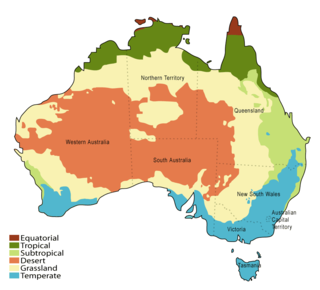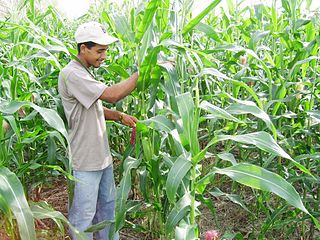
Although Australia is mostly arid, the nation is a major agricultural producer and exporter, with over 325,300 people employed in agriculture, forestry and fishing as of February 2015. Agriculture and its closely related sectors earn $155 billion a year for a 12% share of GDP. Farmers and grazers own 135,997 farms, covering 61% of Australia's landmass. Across the country, there is a mix of irrigation and dry-land farming. The success of Australia in becoming a major agricultural power despite the odds is facilitated by its policies of long-term visions and promotion of agricultural reforms that greatly increased the country's agricultural industry.

Agriculture in Cuba has played an important part in the economy for several hundred years. Today, it contributes less than 10% to the gross domestic product (GDP), but it employs about 20% of the working population. About 30% of the country's land is used for crop cultivation.

The primary form of agriculture in Sri Lanka is rice production. Rice is cultivated during Maha and Yala seasons. Tea is cultivated in the central highlands and is a major source of foreign exchange. Vegetables, fruits and oilseed crops are also cultivated in the country. There are two Agriculture Parks abbreviated as A. Parks established by the Department of Agriculture. Out of the total population in Sri Lanka, 27.1% engages in agricultural activities. Agriculture accounted for 7.4% of the GDP in 2020.

Agriculture in the Philippines is a major sector of the economy, ranking third among the sectors in 2022 behind only Services and Industry. Its outputs include staples like rice and corn, but also export crops such as coffee, cavendish banana, pineapple and pineapple products, coconut, sugar, and mango. The sector continues to face challenges, however, due to the pressures of a growing population. As of 2022, the sector employs 24% of the Filipino workforce and it accounted for 8.9% of the total GDP.

Agriculture is one of the main industries in Taiwan. It contributes to the food security, rural development and conservation of Taiwan. Around 24% of Taiwan's land is used for farming.

Agriculture in Ethiopia is the foundation of the country's economy, accounting for half of gross domestic product (GDP), 83.9% of exports, and 80% of total employment.
Uganda's favorable soil conditions and climate have contributed to the country's agricultural success. Most areas of Uganda have usually received plenty of rain. In some years, small areas of the southeast and southwest have averaged more than 150 millimeters per month. In the north, there is often a short dry season in December and January. Temperatures vary only a few degrees above or below 20 °C but are moderated by differences in altitude.

Indonesia was the fourth-largest producer of coffee in the world in 2014. Coffee cultivation in Indonesia began in the late 1600s and early 1700s, in the early Dutch colonial period, and has played an important part in the growth of the country. Indonesia is geographically and climatologically well-suited for coffee plantations, near the equator and with numerous interior mountainous regions on its main islands, creating well-suited microclimates for the growth and production of coffee.

The role of agriculture in the Bolivian economy in the late 1980s expanded as the collapse of the tin industry forced the country to diversify its productive and export base. Agricultural production as a share of GDP was approximately 23 percent in 1987, compared with 30 percent in 1960 and a low of just under 17 percent in 1979. The recession of the 1980s, along with unfavorable weather conditions, particularly droughts and floods, hampered output. Agriculture employed about 46 percent of the country's labor force in 1987. Most production, with the exception of coca, focused on the domestic market and self-sufficiency in food. Agricultural exports accounted for only about 15 percent of total exports in the late 1980s, depending on weather conditions and commodity prices for agricultural goods, hydrocarbons, and minerals.

Throughout its history, agriculture in Paraguay has been the mainstay of the economy. This trend has continued today and in the late 1980s the agricultural sector generally accounted for 48 percent of the nation's employment, 23 percent of GDP, and 98 percent of export earnings. The sector comprised a strong food and cash crop base, a large livestock subsector including cattle ranching and beef production, and a vibrant timber industry.

Rice production in Thailand represents a significant portion of the Thai economy and labor force. In 2017, the value of all Thai rice traded was 174.5 billion baht, about 12.9% of all farm production. Of the 40% of Thais who work in agriculture, 16 million of them are rice farmers by one estimate.

Agriculture in Panama is an important sector of the Panamanian economy. Major agricultural products include bananas, cocoa beans, coffee, coconuts, timber, beef, chicken, shrimp, corn, potatoes, rice, soybeans, and sugar cane.

The coffee production in Mexico is the world's 8th largest with 252,000 tonnes produced in 2009, and is mainly concentrated to the south central to southern regions of the country. The coffee is mainly arabica, which grows particularly well in the coastal region of Soconusco, Chiapas, near the border of Guatemala.

Coffee production in Papua New Guinea is the country's second largest agricultural export, after oil palm, and employs approximately 2.5 million people. It accounts for approximately 1% of world production, according to the United Nations Conference on Trade and Development (UNCTAD).

Coffee is Uganda's top-earning export crop. In 1989 Uganda's coffee production capacity exceeded its quota of 2.3 million bags, but export volumes were still diminished by economic and security problems, and large amounts of coffee beans were still being smuggled out of Uganda for sale in neighbouring countries. Uganda is one of the few countries in the world with indigenous coffee, with Robusta coffee growing wild around Lake Victoria.

Coffee production in Democratic Republic of the Congo (DRC) is centered in the Lake Kivu provinces. There are about 11,000 coffee farmers in the country who produce two main species of coffee, Robusta and Arabica.

Thailand is one of the top 25 coffee producers in the world as of 2014, but its status as a coffee origin has not been widely known. Thailand traditionally produced mainly Robusta for industrial use, but the country has quickly become an exciting emerging origin for specialty Arabica and fine Robusta coffees. The origin is unique in that it exports very little coffee and most of the consumption remains in the country. There is a booming specialty coffee ecosystem where farmers, roasters, cafes and consumers symbiotically co-exist. It is often seen as an example of a working coffee ecosystem for an origin where coffee produced is sustainable from both economic and environmental perspectives.

Agriculture is the main part of Tanzania's economy. As of 2016, Tanzania had over 44 million hectares of arable land with only 33 percent of this amount in cultivation. Almost 70 percent of the rich population live in rural areas, and almost all of them are involved in the farming sector. Land is a vital asset in ensuring food security, and among the nine main food crops in Tanzania are maize, sorghum, millet, rice, wheat, beans, cassava, potatoes, and bananas. The agricultural industry makes a large contribution to the country's foreign exchange earnings, with more than US$1 billion in earnings from cash crop exports.
The chocolate industry in the Philippines developed after the introduction of the cocoa tree to Philippine agriculture. The growing of cacao or cocoa boasts a long history stretching from the colonial times. Originating from Mesoamerican forests, cacao was first introduced by the Spanish colonizers four centuries ago. Since then the Philippine cocoa industry has been the primary producer of cocoa beans in Southeast Asia. There are many areas of production of cacao in the Philippines, owing to soil and climate. The chocolate industry is currently on a small to medium scale.
Benguet coffee, also known as Benguet arabica, is a single-origin coffee varietal grown in the Cordillera highlands of the northern Philippines since the 19th century. It belongs to the species Coffea arabica, of the Typica variety. It is one of the main crops of farmers in the province of Benguet, which has a climate highly suitable for arabica cultivation. Benguet coffee is listed in the Ark of Taste international catalogue of endangered heritage foods by the Slow Food movement.



















